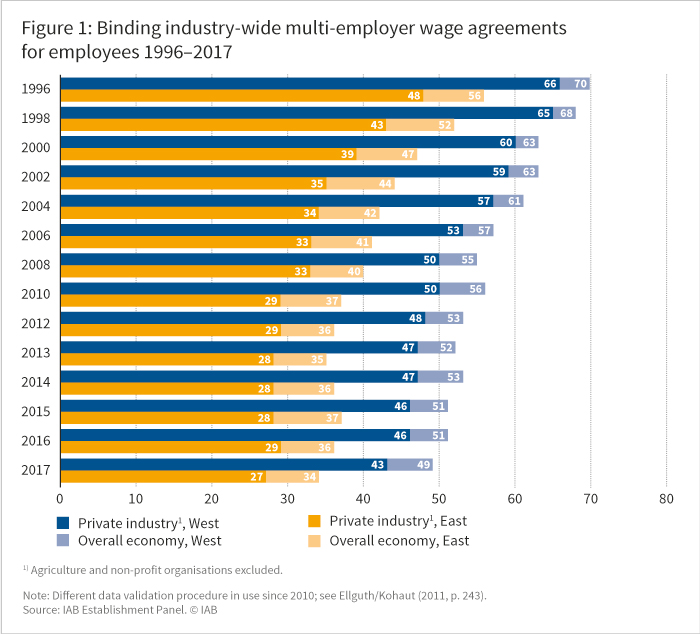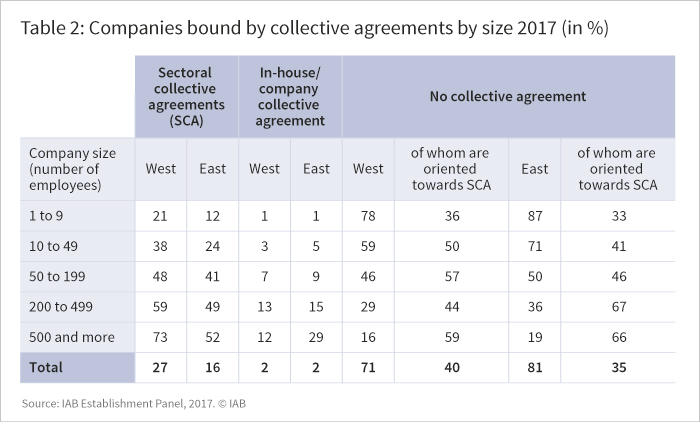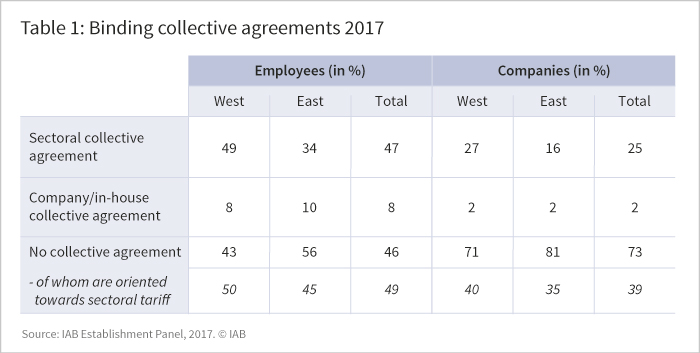4. June 2018 | Labour Market, Employment and Social Policy
Binding collective agreements: The downward trend continues

The foundation of the German work relations system is the legal stipulations governing free collective bargaining and workforce representation by works councils (for the distribution of works councils, see Peter Ellguth’s contribution “Codetermination losing ground” in this magazine.) Sectoral inter-company agreements or industry-wide multi-employer agreements play an important role in governing working conditions and the wage-setting process. They are usually negotiated for regions and industries, ensuring consistent competitive conditions in labour costs.
This gives companies a sound basis for planning. Moreover, they guarantee industrial peace during the term of the agreements. The complex task of negotiating wages and working conditions is mainly delegated to the bargaining parties, which relieves the companies.
Collective agreements set the minimum standards
However, (multi-employer) wage agreements at industry level are not the only way to govern wages and working conditions: it is also possible to conclude agreements at the company or establishment level (company collective agreements) or individual employment contracts. The latter are mainly used in smaller companies. Company collective agreements are an interesting alternative for larger companies, because the administrative overhead will quickly get out of hand if individual employment contracts must be negotiated with every single employee.
In labour law, collective agreements take precedence over company agreements and individual employment contracts. Collective agreements set the minimum standards which may be exceeded, but never undercut, by companies bound by collective agreement. Exceptions are only allowed for opening clauses in collective agreements.
Companies which are not formally bound by collective agreements but are voluntarily oriented towards a sectoral collective agreement nevertheless are not so much in the centre of attention. But if we are trying to estimate how important industry-wide multi-employer wage agreements actually are to the economy, those companies must be considered as well.
Since 1996, the IAB Establishment Panel has collected information on binding collective agreements for both East and West Germany every year (see the “IAB Establishment Panel” info box). The current results are based on information provided by approx. 15,500 companies in both parts of the country. Due to the structure of the random sample, the results are representative for the approx. 2.1 million companies with at least one employee subject to social security contributions. A total of roughly 40 million people are currently employed by these companies.
Binding collective agreements in public service have largely remained stable
From the beginning of the studies in 1996 until the mid-2000s, there was a strong downward trend in sectoral binding collective agreements in all of Germany. After that, coverage remained more or less stable until 2010 in West Germany; in East Germany, there was no stabilisation until after 2010. Currently, both parts of the country are seeing another slight downward trend. It remains to be seen in the next few years whether that trend continues.
In the overall economy, the share of employees in companies bound by sectoral collective agreements went down by 21 percentage points in West Germany and by 22 percentage points in East Germany between 1996 and 2017 (see Figure 1). This development is largely due to the decrease in sectoral binding collective agreements in the private industry; binding industry-wide multi-employer wage agreements in the public sector largely remained stable during the period under observation. 
Sectoral tariffs apply to almost half of the employees in West Germany
Currently (2017), the extrapolation shows that roughly 49 percent of West German and 34 percent of East German employees work in companies bound by sectoral collective agreements. Company or in-house collective agreements apply to 8 percent of West German and 10 percent of East German employees. Approx. 43 percent of West Germans and 56 percent of East German employees have no collective agreements at all. However, almost half of these employees (West: 50 %, East: 45 %) are indirectly subject to collective agreements, because the companies which employ them are by their own accounts oriented towards the respective applicable sectoral collective agreements (see Table 1).
More than 70 percent of companies are not bound by collective agreements
The extrapolation shows that roughly 27 percent of West German and 16 percent of East German companies are still bound by sectoral collective agreements. Company or in-house collective agreements apply to 2 percent of companies in the old and new federal states, respectively. All other companies, i. e. approx. 71 percent of West German and even 81 percent of East German companies, are not bound by collective agreements.
Even so, roughly 40 percent of West German and 35 percent of East German companies without collective agreement stated an orientation towards the existing sectoral tariffs. However, only some of these companies take all relevant points of the respective sectoral tariffs into consideration, e. g. financial benefits such as a Christmas or holiday bonus, working hours, or the amount of annual leave days. In 2011 (there is no information more current than that available), this was true for only 19 percent of the West German and 25 percent of the East German companies without collective agreement. So these were the only companies where employees could hope to work under conditions which were largely comparable to the conditions in companies bound by sectoral collective agreements.
Coverage strongly varies with industry and company size
The extent of binding collective agreements has always varied strongly from industry to industry. For instance, the coverage of binding collective agreements in financial and insurance services as well as the construction industry has been way above average for years, whereas sectoral collective agreements play almost no role at all in the information and communication industry (for more information see “Daten zur Tarifbindung und betrieblichen Interessenvertretung“)

In addition, larger companies tend to be more likely to be bound by collective agreements (see Table 2). That is true for both the old and the new federal states, although at different levels. While sectoral collective agreements play only a subordinate role in small companies, the majority of large companies with 200 employees or more is subject to binding collective agreements. Similarly, the relevance of in-house or company collective agreements increases with company size. Particularly in large East German companies with 500 employees or more, company collective agreements play a vital role.
Conclusion
Binding collective agreements have been on a decline for years in both East and West Germany. This process of erosion may be slow and gradual, but the trend as such is still clear and ongoing. Although many companies continue to use sectoral collective agreements as a frame of reference in negotiating wages and working conditions, there is no legal obligation to do so in such companies, which leads to a lack of security for the employees.
IAB Establishment Panel
The IAB Establishment Panel is the only representative data source which provides annual results across all companies and industries to workforce representation institutions. Since 1996 it has collected information on binding collective agreements and company workforce representation, so that companies can also be tracked over a longer period of time.
Bibliography
IAB Establishment Panel
The IAB Establishment Panel is the only representative data source which provides annual results across all companies and industries to workforce representation institutions. Since 1996 it has collected information on binding collective agreements and company workforce representation, so that companies can also be tracked over a longer period of time.
Ellguth, Peter; Kohaut, Susanne (2012): Tarifbindung und betriebliche Interessensvertretung: Aktuelle Ergebnisse aus dem IAB-Betriebspanel 2011, in: WSI-Mitteilungen 65 (4), p. 297–305
Ellguth, Peter; Kohaut, Susanne; Möller, Iris (2014): The IAB-Establishment Panel – methodological essentials and data quality, in: Journal for Labour Market Research 47 (1-2), p. 27-41
An article on the distribution of works councils by Peter Ellguth also based on IAB Establishment Panel data will be published in this magazine on June 14th, 2018 .
Kohaut, Susanne (2018): Binding collective agreements: The downward trend continues, In: IAB-Forum 4th of June 2018, https://www.iab-forum.de/en/binding-collective-agreements-the-downward-trend-continues/, Retrieved: 2nd of April 2025
Diese Publikation ist unter folgender Creative-Commons-Lizenz veröffentlicht: Namensnennung – Weitergabe unter gleichen Bedingungen 4.0 International (CC BY-SA 4.0): https://creativecommons.org/licenses/by-sa/4.0/deed.de
Authors:
- Susanne Kohaut


 Since 1994 Dr. Susanne Kohaut has been working as a senior researcher at the IAB.
Since 1994 Dr. Susanne Kohaut has been working as a senior researcher at the IAB.